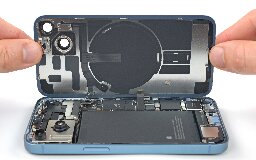[ifixit] We Are Retroactively Dropping the iPhone’s Repairability Score



ifixit.com
[ifixit] We Are Retroactively Dropping the iPhone’s Repairability Score::We need to have a serious chat about iPhone repairability. We judged the phones of yesteryear by how easy they were to take apart—screws, glues, how hard it was…
You are viewing a single comment
"Why don't you buy Apple products?"
Me: Gestures broadly at this:
Mmmm.. DRM for your replacement parts for over $1,200 devices that you already paid for. That's what this society needs.
Ever the innovators. Just not how we the consumers envisioned it.
Innovation on how to make consumers more miserable
I think calling it DRM is incorrect. I think Apple and its audience belief you should be able to tell if a replacement part could be counterfeit, and possibly have a security vulnerability as a result. However, it should be a one-time notice that a user can dismiss and continue using the phone's complete functionality.
For example, if someone replaces a camera module, Face ID could technically be compromised. That said, the security for Face ID is on the device itself, and replacing the module with a third-party one, as long as they was made aware it may not be as secure as the original part, let them do what they want with their own device.
EDIT: If it were me, I would want to know a part in my phone is not directly from Apple, but I would still want the ability to determine if I want to continue using the phone like that or straight up replace it. It should be the user's decision.
Hmm, I broadly agree with the idea that users should be able to dismiss these warnings and repair their devices however they want, but I'd imagine a dodgy repair shop would just press 'OK' on the counterfeit part warning before handing it back to the client.
Not sure what the solution is - maybe a screen in the settings that can list all parts warnings so an owner can view it after a repair? That relies on people actually checking, but at some point users need to show some responsibility for verifying a repair was done correctly if they'd care.
Email the warning to the user's Apple account? Put the warning behind the faceid lock?
Why does the notification have to be on the device and/or accessible by the repair shop?
Great idea - I like yours better than mine.
I was just using an example, but I was thinking something closer to a device "security status" section in the settings app.
Apple actually already sort of have it — you can go to settings and check whether any repairs/tampering happened on your device. That is I believe a correct approach - you can always check after a repair/second hand buy whether their claims are true, yet it is maximally usable.
Do what Google does when trying to grant far reaching permissions to another account. Show a non-dismissible banner or nag notification constantly for 10 days, and then allow the user to dismiss permanently. It’s the best of both worlds. It makes it impossible for the user to miss, even if a shady repair shop tries to cheat them with aftermarket parts, but it gives the user a reasonable course to permanently dismiss any warnings.
We almost need a new term for this, because Digital Rights Management (DRM) is usually for digital media. I'd almost want to call this Physical Rights Management, since it's controlling our right to physically repair and swap parts.
It’s called “right to repair”, if I’m not mistaken.
Right to repair is the term from the consumer perspective. I'm talking about a term for the anti-repair locks that Apple is putting in their products (since DRM doesn't quite fit, though it's close)
I agree to some extent. And I believe that's how ingenuine parts were treated by iOS before now.
But locking its functionality? That's some bullshit.
Well at least now we get to feel the same way John Deere customers feel
Come on, say it with me
"You will own nothing,"